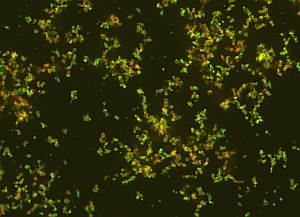Researchers at Massachusetts Institute of Technology, Harvard University, and Brigham and Women’s Hospital in Boston have developed nanoscale particles that can deliver antibiotics in larger quantities, but directly to the targeted bacteria to overcome drug resistance. The findings of the engineering, computer science, and health sciences team appear online in the journal ACS Nano (paid subscription required).
The research aimed to develop a method of delivering antibiotics that would be effective, yet mitigate the side effects of some antibiotics and protect the beneficial bacteria that normally live in human bodies. For this purpose first author and chemical engineering graduate student Aleks Radovic-Moreno and colleagues devised nanoparticles from a polymer capped with polyethylene glycol, a common, non-toxic drug delivery material that can help nanoparticles travel through the bloodstream by evading detection by the immune system.
To target the bacterial cells, the researchers designed antibiotic-carrying nanoparticles that can switch their charge depending on their environment. Previous attempts using positive-charged nanoparticles were negated by the body’s clearing of the particles before they can encounter bacteria.
Radovic-Moreno and colleagues address this issue by giving their particles a slight negative charge, while they circulate in the bloodstream. When these nanoparticles meet an infection site, the particles gain a positive charge, allowing them to tightly bind to bacteria and release their drug payload. This switch is triggered by a slight acidic environment surrounding bacteria, caused by the infection and the body’s immune cells.
The team designed the particles with a pH-sensitive layer made of long chains of the amino acid histidine, just below the polyethylene glycol cap. As the acid content in the cell environment increases, the pH level drops, and the polyhistidine molecule tends to gain protons, giving the molecule a positive charge.
The nanoparticles in this study delivered the antibiotic vancomycin, often prescribed to treat colitis, stored in the core of the nanoparticles. Antibiotics can lose their effectiveness as acidity increases, but the researchers found that in lab tests the vancomycin carried by nanoparticles retained its potency better than traditional antibiotics in an acidic environment.
The designed nanoparticles also released their payloads over one to two days. “You want an extended release of drug,” says Radovic-Moreno, “so that bacteria are constantly being hit with high quantities of drug until they’ve been eradicated.”
The improved targeting and longer duration of antibiotic release provide the potential to overcome resistance to antibiotics, while avoiding the toxicity of higher doses. Further development is expected to address the issue of negatively charged tissue cells and proteins at infection sites that can compete with bacteria in binding to nanoparticles and potentially block them from binding to bacteria. The researchers are also testing the technology with animals to determine if the particles will remain pH-sensitive in the body and circulate for long enough to reach their targets.
Read more: Superbug Therapy Based on University Research in Development
* * *


 RSS - Posts
RSS - Posts
You must be logged in to post a comment.